This web page describes the second leg of the third 1997 sailing trip with S/Y Thetis in the Aegean and Eastern Mediterranean. It covers our stay in Kas, Turkey, passage to the Greek island of Kastellorizo across from Kas, and another stay in Kas with land excursions nearby (Saklikent Gorge, Patara, Xanthus, Gömbe). The web page is illustrated with photographs, also included are historical and geographical descriptions of the places visited as well as several links to other related web sites.
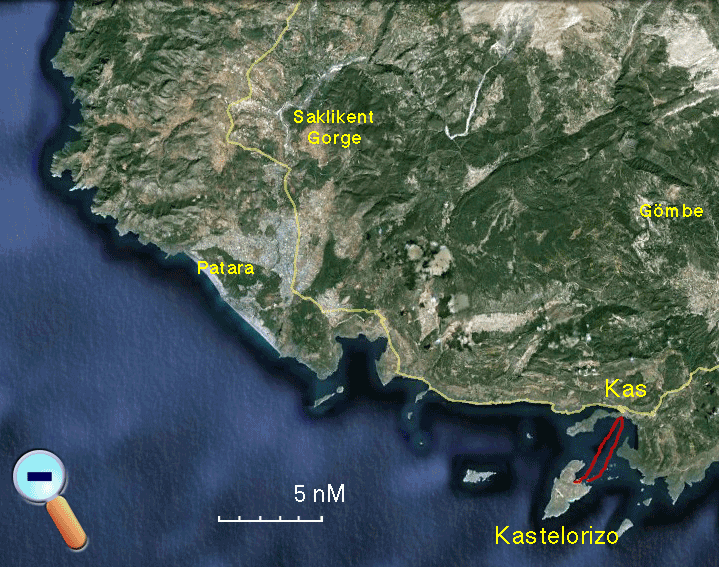
Tuesday August 19, 1997 Day 12
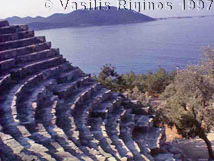
Kas which means eyebrow in Turkish, is the Greek town of Antiphellus and was populated by Greeks until the 1923 population exchage after the disastrous Greek-Turkish war. In antiquity it was the Lycian city of Habesos. During Roman times it was an important sponge trading center.
In the morning we walked to the Hellenistic theater, which is just out of the town. From the theater there is an exquisit view of the islands Ro and Kastellorizo. Next to the theater there are a number of Lycian tombs, in bad shape, and a small Doric temple, also in a pitiful state. On our way back we shaw a train of cars pulled by a tractor which takes customers to a disco.
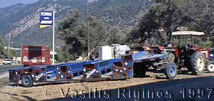
As the day progressed it became extremely hot. Alice and I tried to locate the harbor master for an exit stamp from Turkey so that we could go to Kastellorizo where Corinna was to fly out to Athens on Friday and where we were to meet with Nikos. We could not locate the harbor master’s office but found the customs. They directed us to the harbor master and also told us the rules: we must surrender the boat’s transit log and exit the country, on our way back we must get a new transit log. All of this, of course, means more money, another $160? We finally did locate the harbor master’s office but it was closed. After inquiries I found that it opens after 13:30. As I was near heat exhaustion, I went for a swim behind the jetty. We then had a light lunch under the tent which we had hosed with water to cool the boat.
Back to the harbor master’s office we went and he stamped the transit log and then we trekked to the other end of the town in search for the passport police. After several false starts we located the office and got another stamp on the transit log plus exit stamps on our passports. Then back to the customs. There a very gracious customs chief invited us to his air-conditioned office and while his underling, who spoke impeccable English, prepared the papers he offered us çay (tea). Another stamp to the transit log! But it was not over yet. We had to go to the office next door, not an air-conditioned one, that housed the “custom’s patrol.” They stamped once again and took the transit log and asked for 5 million TL and for a docking fee (later we learned that Nikos, at the very same office, was not asked to pay this). After paying the docking fee, another 1.5 million, we finally left Kas at 15:10.
We motored for 50 minutes the 4.2 M to Kastellorizo [36° 09.1' N 29° 35.5' E]. The Faneromeni (my brother Nikos’ boat) was indeed there and we docked near her but there was no sign of either Nikos nor Rozina. Also Argos, Nikos’ dog, and his inflatable were missing. Kastellorizo is very small and picturesque. Just one street along the waterfront. No cars. No motorcycles. No gulets. The houses all face the sea and are all freshly painted. Many inland houses were being restored. There was an air of serenity in the place.
Later in the afternoon Nikos, Rozina, some friends, and Argos returned. We sat at the restaurant next to the Faneromeni, had a cool drink, and brought each other up to date with our activities. Later Nikos invited us, and his friends, Marie, her daughter and son and her mother Mrs. Nina, for dinner. Marie grew up in Burundi, Africa. Now she lives in Rhodes with her husband. Two years ago they bought and old house in Kastellorizo which they have restored. Her mother also now lives in Rhodes and is very charming. After dinner Marie invited us to their home for a very good baklava. So our visit to Kastellorizo, has begun.
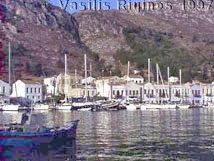
Wednesday August 20, 1997 Day 13
Kastellorizo, (Καστελλόριζο) the ancient Megisti, or Meis in Turkish, is the easternmost part of Greece and certainly the most isolated, being 70 M East of Rhodes. During the 19th and early 20th century it was fairly prosperous with a large trading fleet and had more than 20,000 inhabitants. For a period of time it was even a refueling stop for the Air France seaplanes flying to Lebanon. Following the 1921 Greco-Turkish war the inhabitants lost their land holdings and trade with Asia-Minor and the island economy went into steep decline. Many islanders migrated to Australia. During World War II the island was forcefully temporarily depopulated by the British. Today there are only 200 inhabitants (there are more Kastellorizoi in Sydney) but with many subsidies from Athens many of the old houses are being restored.
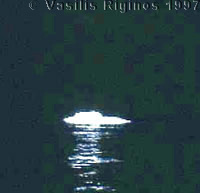
We left the boat around 9:00 with Nikos and Rozina in his inflatable to visit the “Blue Grotto” which is located a few miles SW of the harbor. The cave’s mouth is very low over the surface of the sea and we all had to lie down for the inflatable to squeeze into the grotto. Once inside, and after our eyes got adjusted, the grotto is quite a spectacle. The sun light filters through the sea water and illuminates the cave with a deep blue light which appears to originate from below the surface. The cave is about 50 m long and its inner end is a tiny pebble beach which we speculated may be a breeding ground for seals. It is very deep. We went swimming in the cave. The bodies of the swimmers appeared a ghostly blue.
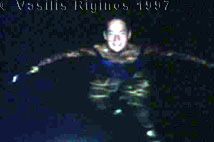
Later, after returning to the harbor, we raised our anchor and moved Thetis to a new position along side the Faneromeni. Corinna executed the whole maneuver without any instructions or advice from me: I just followed her orders.
As the day progressed it became hotter and hotter. I put the outboard on the zodiac and Alice and I went outside the harbor for a swim. Later, I connected the AC battery charger to one of the 220V AC outlets of the Faneromeni (Nikos was already connected to the AC ashore at the restaurant) and tested the new circuit (it was installed last winter and I had not had the change to test it yet). While it appeared to charge, as indicated by the analog ammeter on the charger, the Ah meter did not show any current. I traced the wiring and found that the negative lead from the charger was connected directly to the negative pole of one of the service batteries instead of the ground post of the shunt. It took me some time in the hot and cramped space to re-wire but at the end there was total success.
In the evening, after a shower, I had a pleasant ouzo at one of the taverns while waiting for everyone else to get ready. Finally everyone was there and we walked to Mrs. Marie Merkouriou’s house where we were invited to dinner. Her mother, Mrs. Nina, had prepared a sumptuous meal which began with chicken-trahana (kind of wheat) soup, followed by fresh fasolakia (green beans), salad, and baked baby goat stuffed with pine nuts, meat, and other goodies. It was fantastic! Then the meal ended with a Kastellorizo specialty: katoumaria (κατουμάρια), honey dipped wheat strings, utterly delicious. They were prepared by Kyria Betty a friend of Mrs. Nina who is genuine Καστελλοριζιά (Kastellorizia) who lives for half of the year in Kastellorizo and for the other half in Sydney, Australia.
Thursday August 21, 1997 Day 14
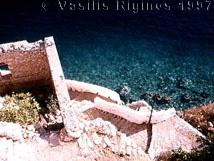
In the relatively early morning coolness Alice, Corinna, and I walked to the Castle (this is the Castelo Roso after which the island is named) and the museum. The museum which is housed in a restored building within the castle consists of 2-3 small rooms with antiquities (not too exiting since the best pieces are in the National Museum in Athens) and some rather interesting ethnographic material (old photographs, costumes, embroideries, etc.). Mr. Elias, the guard, gave us a complete tour of the museum as well as an overview of the recent history of Kastellorizo. He is a fountain of local lore.
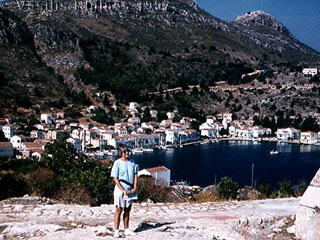
He told us how during the war the British, after evacuating the inhabitants, set the houses on fire to prevent repartiation. He also told us the story of the Lady of Ro who after being widowed tended her husband’s flocks on the small island of Ro. She refused to be evacuated and stayed all by herself on the island during the war years and everyday, without fail, raised the Greek flag. She died just a few years ago. At the end of our visit he offered us a συκαλάκι (glazed small fig), another traditional Kastellorizo specialty.
Later, after walking back to the town, we sat at a waterfront cafe, under a white umbrella, and while drinking freshly squeezed orange juice, watched all the people go by. Kastellorizo is a lovely, low key, slightly sleepy place where the main occupation of everyone is to watch everyone else. The tranquillity of the place was, unfortunately ruined by the very large motor cruiser Tindareo, belonging to the owner of the Fage company which sells yogurt and other milk products, that came and docked right next to the Faneromeni. She not only fouled both our anchors but kept her diesel generators continuously running, resulting in both air and noise pollution. Also I later found all the fenders as well as the zodiac were covered with thick black oil, which I suspect came from our friend the Tindareo.
Yesterday, coming back from the Blue Grotto as we were passing Mandraki, we noticed a Jeanneau Sunshine anchored there. Today, her owner came and introduced himself. He is Jono Farmer from Australia and he has had his boat Zephyros for many years. I invited him to come aboard Thetis and take a look. He was very much impressed with our electronics and how clean our engine was. He invited us to come and visit his boat.
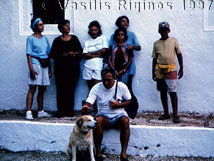
In the afternoon, Alice and I once again escaped the heat by taking the zodiac for a swim. In the late afternoon, as we had arranged yesterday, we were joined by Marie, her children George and Jacqueline, Mrs. Nina, Nikos, and Rozina for a hike up the steps of the steep hill to the monastery of Άγιος Γιώργης ο Βουνιός (St. George of the Mountain). It was a good walk and being at the end of the day it was not too hot and the view was worth it. The monastery is interesting but in a state of great abandonment, only the church is maintained. It was founded by Osios Anthimos and it was never fully staffed. Under the church there is a crypt, that is rather hard to climb down to.
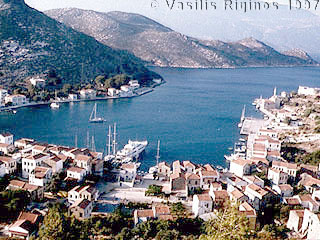
After walking back to town we all had dinner which was followed by homemade Halva, made Mrs. Betty and served at Marie’s house. Although I was sleepy and tired from the hike, I did not sleep very well thanks to cruiser’s noise and diesel fumes.
Friday August 22, 1997 Day 15
This is the day Corinna left Thetis. She got into the small bus that services the tiny airport at 8:00 and was on her way to Rhodes where she caught a connection to Athens. At around 9:00 Nikos and I agitated with the cruiser because we both wanted to leave and she had fouled our chains. Finally at 10:00 Thetis managed to disengage her anchor and we went to Mandraki [36° 09' N 29° 35.9' E] where we anchored off to wait word of Corinna’s safe arrival in Athens before leaving for Kas.
Nikos was not so lucky because the Faneromeni’s chain was well caught by the cruiser. After Nikos made several futile attempts to disangage, the cruiser had to untie their lines and lift their anchors. But Nikos’ troubles were not yet over as his anchor was also fouled with the chain of another boat. They did not leave for at least another hour. Around 12:00 Nikos hailed us on the VHF to tel us that they were pulling into the Kas harbor.
In the mean time, I visited the S/Y Zephyros, a Jeanneau Sunshine almost identical with Thetis. They have made several modifications. I liked the system for removing the main scota (main sheet) so that it does not block the companionway. But I did not like the opening of a sea looking port on the aft cabins, for this can be dangerous. I also liked the way they have installed wire frame shelves on their refrigerator. Also it seems that their oven, unlike Thetis’, works fine.
At 13:40, after having heard from Corinna, we too left for Kas and by 14:20 we were docked without any difficulties. All four of us–Nikos, Rozina, Alice, and I–went to the harbor master’s office where we were issued new transit logs for 5 million TL (about $35) each. A far cry from the $160 we had to pay in Datça where we used the good services of the marina. After the harbor master affixed his seal on the transit logs, we went to the health official for his stamp, then the passport police, customs, and customs patrol. All stamped our logs but no one asked for any more fees. All of this did take some time and it was hot.
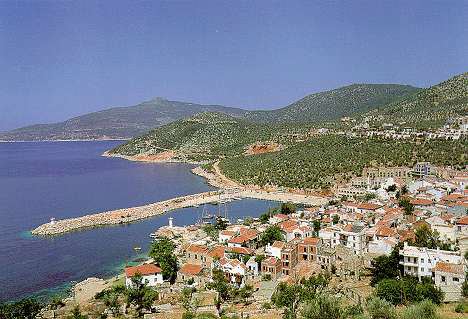
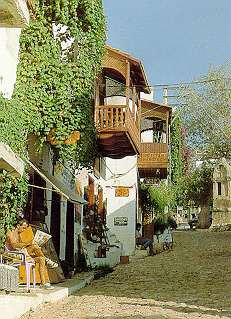
Later in the harbor we connected with AC electricity, filled our tanks with water, and I topped with 70 L of diesel from the patrolling tanker truck. Our friend, the harbor manager, came, and charged us only 1 million TL/night since we had been there before.
After showers etc. we went out for dinner at the same delightful garden restaurant (Bahçe) where we had eaten before. We then made arrangements for renting a Turkish Fiat starting tomorrow for $44/day. Also we got several suggestions from the harbor manager and the car rental office on where to go. We integrated this information together with the information from several travel books.
Saturday August 23, 1997 Day 16
We could not leave the boats until all the gulets that could have fouled our anchors had left the harbor, so we were stuck until about 10:30.
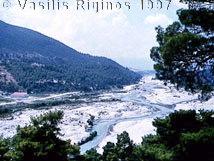
We then got into the car, and with Nikos driving headed for the Saklikent Gorge about 80 km NW of Kas. We had some difficulty finding the turnoff from the highway since the signs leave something to be desired but eventually found our way. Approaching the gorge were several restaurants under shady trees with rugs and a lady in costume by an oven making Gözleme (a kind of thin pita bread). As the car approached each restaurant they turned on water showers, sprinkling the ground in front of the establishment. There were as many styles and variations of the shower motif as there were restaurants, all of which were empty of customers.
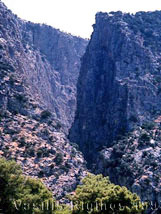
Eventually we reached the gorge area. It was crowded with cars and we had some difficulty parking. The entrance to the gorge was packed with people. After paying the entrance fee we walked along with the multitude on a rickety wooden walkway perched on the rock along the river bank until we reached another staging area. The people were of all nationalities but predominately they were Turkish wearing all sorts of clothing from the most conservative costumes with head covers to the most modern bathing suits. There was a restaurant on a wooden platform over the flowing water with rugs and cushions and low tables with Gözleme oven which did look most inviting. To walk in the gorge one had to walk in the ice cold water, some times knee-deep. A small concession was renting plastic shoes and I rented a pair. The gorge is 18 km long and extremely narrow and breathtakingly beautiful. We walked for several kilometers but the rented shoes were giving me a lot trouble and Rozina was also getting tired so we walked back.

Alice in Saklikent |
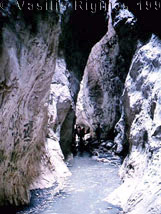
In the Saklikent Gorge |
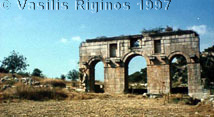
As neither Nikos nor Rozina were hungry Alice and I had a tiny bite from the picnic Alice had packed, and then we drove along the left bank of the river Xanthus, past the Xanthus excavation to the highway and proceeded to Patara. The Patara site is very impressive: there is a Roman theater in very good condition but half buried under sand dunes. Alice and I climbed to the hill over the theater and saw the whole vista of sand dunes and ruins sticking out from the sand. We also saw a structure which no one has ever explained what it was used for. It is a large circular pit about 10 m deep and of an 8-10 m diameter with a square spindle in the middle which rises over the rim. Patara was sacred to Apollo. In modern times Patara was described by the British captain Francis Beaufort, the same one who gave us the wind scale, in his book Karamania. There is also a Roman granary but it was too late in the day and too far for us to walk through the sand to visit. Patara was also the birth place of Saint Nicolas.
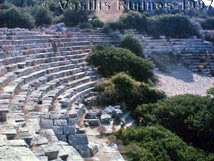
The Theater at Patara |
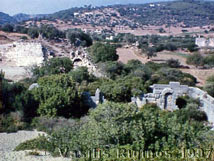
View at Patara |
When we walked back to the car Nikos had made friends with a tiny fellow, who could not had been older than 2, with a very large head. There was no evidence of any adults related to him. Alice took him by the hand and walked him to some near by huts but still there was no sign of anyone there.
We very reluctantly drove off to the estuary of the River Xanthus, slightly north of Patara. We went for a swim, the water was a mixture of fresh and salt water hot and cold. There was a lot of swell and large breaking waves. We also watched an extended family group fishing with a large net. The men waded in the water with one end of the net while the women were holding the other end near the water edge ashore. The men then formed a semi-circle with their net by walking their end back ashore and both sides pulling the net. The group we watched caught 2 fish. We watched a lovely sunset after which we drove back to Kas tired but very pleased.
Later Alice and I went out and had some pide for supper. Unfortunately at the harbor there a was circumcision party going on which was very noisy until well past midnight.
Sunday August 24, 1997 Day 17
This day is Alice’s and mine 30th wedding anniversary! Again like yesterday we waited for most of the day-trip gulets to leave the harbor before we too drove off 90 km of beautiful mountain roads to Gömbe.
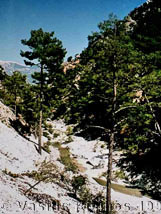
There were a lot pine trees, έλατα (fir trees), uniper trees, and cedars. In the town there was an on-going fair which lasts for a month. There were numerous stalls selling goods of every description: household items, tea sets, trays, clothes of every description, shoes, rugs, wooden furniture, tools, horse paraphernalia etc. Everything was very cheap and we all bought a few things. We must had been the only foreigners in Gömbe that day. When we tried to leave the car was boxed in and we only got out with the help of an enthusiastic group of all ages who lifted and moved the cars blocking our exit.
We then went looking for a restaurant we were told about by the harbor manager that was out of town but near Yeshigöl and that specializes in cutlets (I later learned that what they call cutlets are actually lamb chops). We asked for directions and were pointed at a dirt road. We drove and drove, up a high mountain, totally bald while the road kept getting worse and worse. There were brooks everywhere and clusters of parked cars with people, ladies in costume, on spread rugs grilling meats and eating. We passed a family praying. We did see a sign for a restaurant but since we had not yet reached Yeshigöl we continued until finally almost reached the peak of the mountain and the road became untenable.
Back we went to the restaurant we had seen. It was by a large grove of trees with a wonderful view and while there were no cutlets there were three men who were very eager to please. They offered us some baked meat and salads. Despite some reservations, we stayed. It was cold and we moved to the sunshine. They brought us the salads which were maybe the best we have had in Turkey. The meat took some time and when it came it was baked with spicy tomato sauce and while very tasty it was full of fat and tough.
We then drove via the Elmali road to Finike and Demre (190 km). Demre was the old Myra the bishopric of St. Nicholas. Unfortunately, by the time we got there it was past the 7:00 PM closing time. We also went to the Myra site, also closed. At the entrance of the site there were some camels including a baby one which we petted. We then drove back to Kas. None of us had any appetite. So we returned the car and retired to our boats.
At the harbor there a wedding party which, like the circumcision one of last night, was equally noisy. Fortunately they dispersed around 12:30.